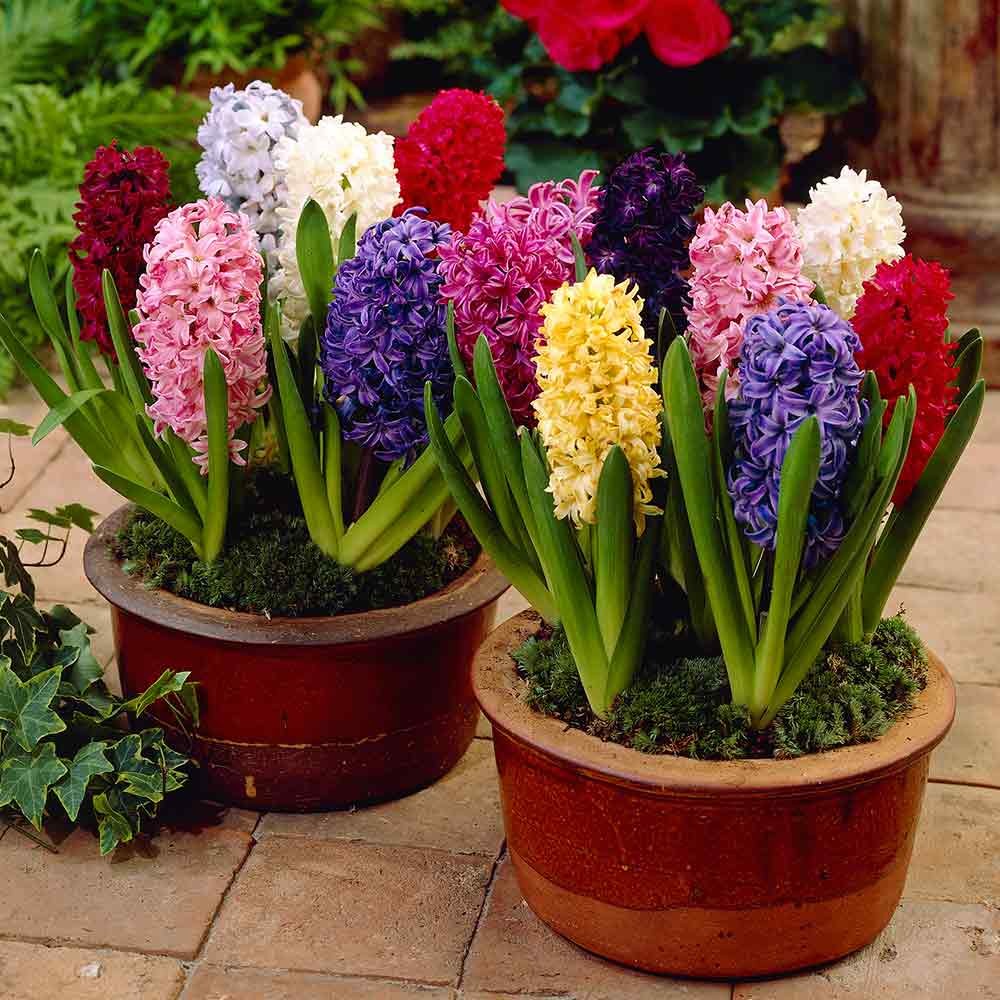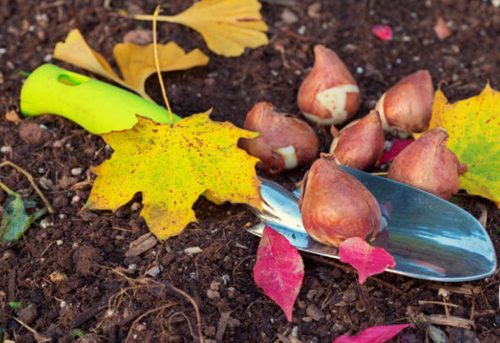With a wide variety of flower colors, these plants are pleasing to the eye. And their aroma is quite pleasant. But when the hyacinth has faded, what to do with the bulb? Its flowering and further development depend on proper care during this period.
It is very pleasant to receive a blooming hyacinth as a gift in winter or early spring. Forcing is on sale during this period - these are small bulbs with inflorescences and leaves. Many people simply throw them away when the flowers have withered. But hyacinth after flowering is quite possible to preserve.
Content
Bulb care after forcing
Usually the plant is sold in small containers where it lacks space, moisture, and nutrients. Forcing simply depletes the bulb. If the situation is completely bad, then the still blooming hyacinth can be carefully transferred with the ground into a larger pot. But this is, so to speak, an "ambulance". Better to wait for it to bloom.
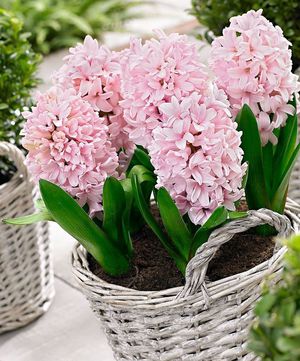 There are two ways keep it after flowering. The main thing is not to dig up the bulb as soon as it has faded. After distillation, she is weak and needs time to recover. The peduncle is cut off. It is better to do the following with leaves: wait until they dry out. If it is a spring forcing, then, if possible, keep the plant with leaves in a pot until July. To do this, he is placed in a dark place.
There are two ways keep it after flowering. The main thing is not to dig up the bulb as soon as it has faded. After distillation, she is weak and needs time to recover. The peduncle is cut off. It is better to do the following with leaves: wait until they dry out. If it is a spring forcing, then, if possible, keep the plant with leaves in a pot until July. To do this, he is placed in a dark place.
Moisturizing needs regular, but infrequent. Complete drought should not be allowed, but it is desirable that the soil dries out between waterings, it is gradually reduced. After the leaves have dried, they are removed., the bulb is removed from the ground.
It is dried and stored in peat chips or sawdust. Usually their planting time is in the fall. With the first frost, they are placed in open ground. If planted on warm autumn days, they can begin to grow, and with the arrival of cold weather they will simply die.
It is good to insulate the beds with hyacinth for the winter with sawdust, peat, leaves or special material. Not all varieties are equally resistant to frost. Therefore, the shelter is removed only when the soil thaws.
But in practice, this is not so easy to implement. Many bulbs do not withstand storage until autumn and simply dry out. It is worth remembering that forcing them depletes and even those that lasted until autumn will bloom only after 2 years.
Another way to preserve the plant is simpler and more effective. When the hyacinth is finished blooming the arrow of the peduncle is cut... If you haven't done a transplant from a small container before, now is the time. A drainage layer must be laid on the bottom of the pot. For this, pebbles or expanded clay are suitable.
You can take the substrate ready-made from the store, or mix ordinary soil with sand and peat. The onion is simply transferred into a new spacious container, without deeply deepening. Now the hyacinth needs to be placed in a warm place with plenty of light. A glazed warm loggia would be a good option, but a window sill is perfect.
It is not difficult to take care of it: it is necessary to water it in moderation, without soaking the onion and not overmoistening the substrate. Complex mineral compositions are suitable for feeding.With this care, hyacinth develops in almost the same conditions as in open soil.
When the plant forms leaves, it can be move to open ground... This should be done in the spring, when frost has passed. Just transplant with a clod of earth into the planting hole without deepening the neck and level the soil. During its stay in the pot, the bulb accumulates nutrients. And next year it is quite possible to expect flowering from it.
There is an important rule: after distilling, the bulbs should not be planted in a pot and try to get them to bloom again. They are emaciated and need a rest period of about 3 months. Many alternate between planting them in open ground and a pot.
Leaving after flowering in the garden
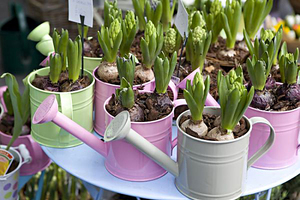 For plants in open ground, the same question is relevant: the hyacinth has faded, what to do next? In principle, all procedures are almost the same as those described above. And in the open field bulb formation and growth occurs precisely after the flowering of the hyacinth.
For plants in open ground, the same question is relevant: the hyacinth has faded, what to do next? In principle, all procedures are almost the same as those described above. And in the open field bulb formation and growth occurs precisely after the flowering of the hyacinth.
The arrow of the peduncle must be cut off even before the seed pods begin to form. The fact is that they take a lot of nutrients from the bulb. But the leaves, on the contrary, supply the substances for its growth. The longer the leaves remain green, the more nutrition it receives. Therefore, it is not necessary to remove them, but it is worth waiting for them to dry out themselves.
It is good to add nitrogen fertilizers. Potash and phosphorus mineral compositions are also suitable. They not only help the bulb to recover after flowering, but also contribute to the formation of children. But you shouldn't overfeed them. Top dressing is added to the soil after watering.
In the open field, after flowering, watering is carried out in the aisles once a week. As soon as the leaves turn yellow, it is stopped. When they are completely dry, it is time to dig.
In theory, bulbs can be grown in one place for several years without digging. However, gardeners advise not to leave them in the ground for the winter, but dig up every year... And there are several reasons for this:
- After wintering, hyacinth may not bloom well. Not all varieties tolerate frost well;
- This way you can get more planting material;
- The bulbs are protected from disease and decay.
Dig them out in the fall and in order to then set them the desired depth. Without this, they can stop blooming altogether. Once dug up, they are also disinfected, sorted and stored. It is important not to miss the moment when the leaves die off. After that, you may not find the bulbs, since the hyacinth grows deep into the ground.
Storage conditions for bulbs
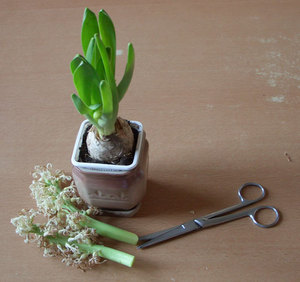 In growing hyacinths, this moment is of great importance. So, before sending the bulbs for storage, you must disinfect in manganese solution... Then dry it, leaving it for a week in the fresh air (not in the sun) or just in a well-ventilated area. The optimum temperature for this is around 20 ° C.
In growing hyacinths, this moment is of great importance. So, before sending the bulbs for storage, you must disinfect in manganese solution... Then dry it, leaving it for a week in the fresh air (not in the sun) or just in a well-ventilated area. The optimum temperature for this is around 20 ° C.
Need cleaning from soil and excess scales. Be especially careful to separate those under which the children are. It is also good to make cruciform incisions on the bottoms of the bulb. It is important to disinfect the knife after handling each one. You can clean it with alcohol.
During sorting, babies are separated from the bulbs if they are easy to detach and have established roots. The seed is put in boxes or paper bags, sprinkled with sawdust.
There are several stages in the storage of bulbs:
- For 8 weeks, the bulbs are kept at t 25 ° C;
- After that, it must be reduced to 18 ° C;
- A few days before disembarkation, it is good to keep them in a cold room (t 4-5 ° C). This will help them adapt to the external environment.
Indoor humidity is also important. The air should be dry, but not dry enough to dry out the bulbs. Good ventilation is also needed. Also, open field bulbs can be stored at home. at a temperature of about 5 ° C... This is done only with adult specimens.
What to do if the bulb is sick? The leaves can turn yellow for this reason as well.In such cases, the planting material must be immediately dug up, held in a dark solution of manganese and put to dry separately from others, having treated them with special preparations.
Hyacinth bulbs contain oxalic acid. It can be irritating for people with sensitive skin, so it is best to protect your hands when working with them.
Preparation of planting material and soil
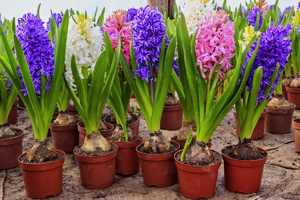 The soil must be prepared before planting hyacinth bulbs in it. When choosing a place, it is better to give preference to a garden bed, which is located under a slight slope. So flooding can be avoidedwhich is very dangerous for the plant. Alternatively, bulk beds with sides are suitable. They will protect the hyacinth from groundwater.
The soil must be prepared before planting hyacinth bulbs in it. When choosing a place, it is better to give preference to a garden bed, which is located under a slight slope. So flooding can be avoidedwhich is very dangerous for the plant. Alternatively, bulk beds with sides are suitable. They will protect the hyacinth from groundwater.
It is better to dig up the soil in advance so that it has time to settle. From fertilizers, minerals and humus can be added to the soil. Ash and dolomite flour are quite applicable.
The bulbs are sorted before planting. It is important that they are not damaged or rotted. Then they are disinfected in potassium permanganate. The procedure is also good for disease prevention. The children formed during the storage period are carefully disconnected and planted in separate containers. Here they will grow and develop.
After pre-planting processing the bulbs are planted in the holesmaking them sandy shirts. Sand is poured onto the bottom of the landing hole, and they are also sprinkled with sand, and only then with soil.
These flowers were brought to Europe in the distant 18th century. And they invariably enjoy well-deserved popularity. How the plant will develop in the future depends on the proper care of hyacinth after flowering. After all, one bulb, with the right approach, can delight with flowering for about 10 years.
